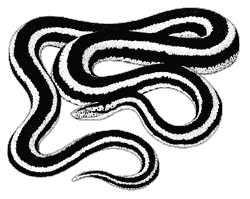Rosy Boa
(Lichanura spp.)
Order: Squamata
Family: Boidae (boas)
Spanish names: corua del desierto
Description
This heavy-bodied, medium-sized snake reaches a length of 3¼ feet (107 cm). The eyes have cat-like vertical pupils; the long, pointed head is barely distinguishable from the neck. Shades of beige, slate blue, or rose on the back are adorned with 3 brown or gray stripes that run the length of the body. The light, creamy or gray underside has flecking of gray or black. Males have a spur on either side of the anal opening.

Range
The rosy boa is restricted to southern California, southwestern Arizona, and northwestern Mexico.
Habitat
The rosy boa inhabits desert foothills with rocks and boulders from sea level to 4500 feet (1400 m). Although this snake prefers rocky terrain where crevices make safe homes, it occasionally is spotted in shrublands or chaparral without rocky areas, although this is unusual.
Life History
Active principally at night, the rosy boa eats birds and mammals. Boas and pythons, unlike most snakes, have a vestigial pelvic girdle complete with rudimentary femur bones. These can be seen as anal spurs located on either side of the anal opening. More pronounced in the male, these shiny, almost metallic looking spurs are used in courtship to gently stroke the female. Mating takes place in spring; females give birth to as many as twelve young in late fall. The young are about 1 foot (90 cm) long at birth.